- Home
- Penny Weight
How Much Does A Penny Weigh?
The most current US penny or one cent coin is known as the Union Shield and this new coinage weighs approximately 2.5 grams or 0.088 ounces.
There are now millions of these copper plated zinc Union Shield cents in circulation.
It is 19.05 mm or 0.75 inches in diameter, 1.52 mm thick, and is made from a Copper Plated Zinc composition which includes 97.5% Zinc and 2.5% Copper.
How many pennies does it take to make $1? The answer is 100 copper pennies. Also there are 25 copper cents in a quarter.
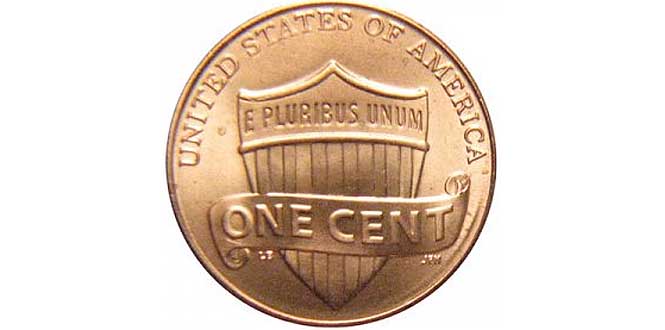 Source: USA Coinbook
Source: USA Coinbook
You may be wondering how many pennies are in a roll?
There are 50 of these US pennies in a roll which weighs approximately 125 grams or 4.4 ounces and equates to a face value of $0.50.
These US one cent pieces or pennies have changed weight and size many times over the years since they were first produced in 1787 in the form of Fugio cents.
The Fugio weighed in at a hefty 10.2 grams (0.36 ounces) and was made from solid copper.
There were other prototype copper cents minted around between 1787 and 1793, namely the 1792 Birch Cent and Silver Center.
However the first large US penny to be officially produced by the United States Mint in 1793 was known as the Flowing Hair Chain.
These early coins were also weighed in Grains so I've included that weight measurement alongside the Grams and Ounces.
United States Cent Weight 1793 - Present
- 1793 - 1795 (13.48g | 0.475oz) 100% Copper
- 1796 - 1857 (10.89g | 0.385oz) 100% Copper
- 1856 - 1864 (4.67g | 0.165oz) 88% Copper 12% Nickel
- 1864 - 1942 (3.11g | 0.11oz) BRONZE 95% Copper 5% Tin & Zinc
- 1943 (2.7g | 0.095oz) Zinc Coated Steel
- 1944 - 1946 (3.11g | 0.11oz) BRASS 95% Copper 5% Zinc
- 1947 - 1961 (3.11g | 0.11oz) BRONZE 95% Copper 5% Tin & Zinc
- 1962 - 1982 (3.11g | 0.11oz) BRASS 95% Copper 5% Zinc
- 1982 - 2008 (2.5g | 0.088oz) 97.5% Zinc 2.5% Copper
- 2009 (3.11g | 0.11oz) BRONZE 95% Copper 5% Tin & Zinc
- 2010 - present (2.5g | 0.088oz) 97.5% Zinc 2.5% Copper
US Pennies Minted 1793 - 1795 (13.48g | 0.475oz | 208gr)
The first large cents produced in the United States were made from 13.48 grams of pure copper.
Between the years 1793 and 1795 the large cent design changed numerous times.
The first copper pennies were designed by Henry Voigt and were known as the Flowing Hair Chain and Flowing Hair Wreath.
These initial large US pennies were quickly superseded by the Liberty Cap designed by Joseph Wright which was also 13.48 grams of pure copper.
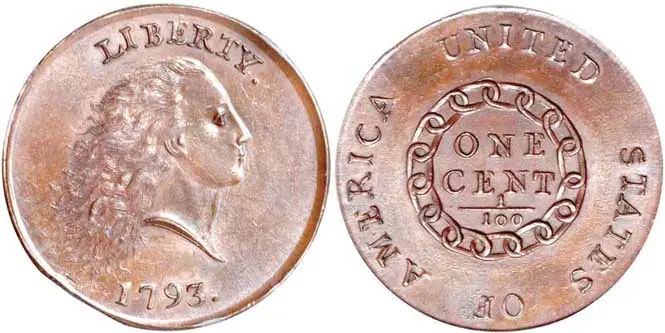 Source: USA Coinbook
Source: USA Coinbook
- Period: 1793
- Penny: Flowing Hair Chain / Wreath
- Designer: Henry Voigt
- Weighed: 13.48 (grams) 0.475 (ounces) 208 (grains)
- Diameter: 27mm
- Composed: 100% Copper
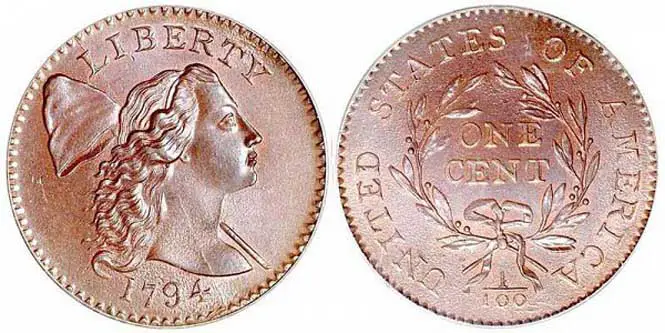 Source: USA Coinbook
Source: USA Coinbook
- Year: 1794
- Penny: Liberty Cap
- Designer: Joseph Wright
- Weighed: 13.48 (grams) 0.475 (ounces) 208 (grains)
- Diameter: 28.5mm
- Composed: 100% Copper
US Pennies Minted 1796 - 1857 (10.89g | 0.385oz | 168gr)
During the period between 1796 and 1857, the large United States cent dropped in weight. These slightly smaller pennies weigh 10.89 grams as opposed to 13.48 grams.
There were four main design changes during this time period, however the coin was still struck from 100% Copper.
The first new design by Robert Scot was minted between 1796 and 1807 and was called the Draped Bust.
In 1804 another design was implemented by John Reich called the Classic Head which lasted until 1814.
1816 saw another new design by Robert Scot in the form of the Coronet Large Cent.
This new design of Coronet was called the Matron Head and lasted until 1839.
From 1839 to 1857, the last design for an US large cent was created by Christian Gobrecht and was named the Braided Hair.
 Source: USA Coinbook
Source: USA Coinbook
- Date: 1796 - 1807
- Penny: Draped Bust
- Designer: Robert Scot
- Weighed: 10.89 (grams) 0.385 (ounces) 168 (grains)
- Diameter: 28mm
- Composed: 100% Copper
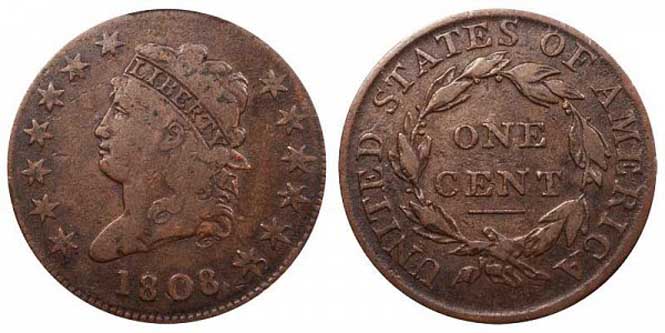 Source: USA Coinbook
Source: USA Coinbook
- Period: 1808 - 1814
- Penny: Classic Head
- Designer: John Reich
- Weighed: 10.89 (grams) 0.385 (ounces) 168 (grains)
- Diameter: 28mm
- Composed: 100% Copper
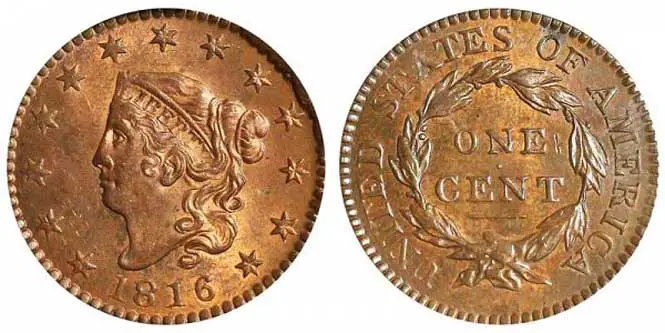 Source: USA Coinbook
Source: USA Coinbook
- Date: 1816 - 1839
- Penny: Matron Head
- Designer: Robert Scot
- Weighed: 10.89 (grams) 0.385 (ounces) 168 (grains)
- Diameter: 28mm
- Composed: 100% Copper
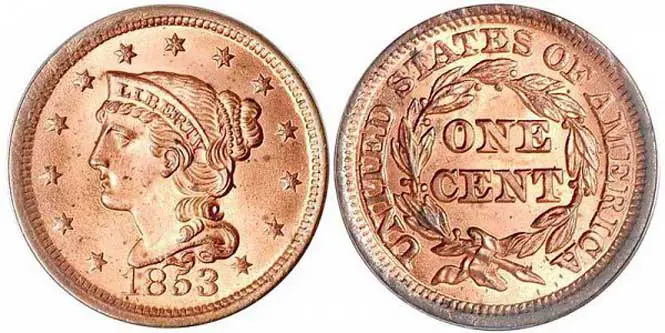 Source: USA Coinbook
Source: USA Coinbook
- Year: 1840 - 1857
- Penny: Braided Hair
- Designer: Christian Gobrecht
- Weighed: 10.89 (grams) 0.385 (ounces) 168 (grains)
- Diameter: 27.5mm
- Composed: 100% Copper
US Pennies Minted 1856 - 1864 (4.7g | 0.165oz | 72.5gr)
Several coins with new designs later, in 1856 the US Mint started to produce small copper cents measuring approximately 19mm as opposed to the previous penny size of 28mm.
The weight and metal composition of the coin also changed quite significantly during this production period.
These new smaller US pennies weigh 4.67 grams and are made from 88% Copper and 12% Nickel. This is the first time that U.S. pennies weren't made from 100% copper.
The designer for these new coins which were struck between 1856 and 1864 was James B Longacre.
The first coin was known as the Flying Eagle and the second was known as the Indian Head.
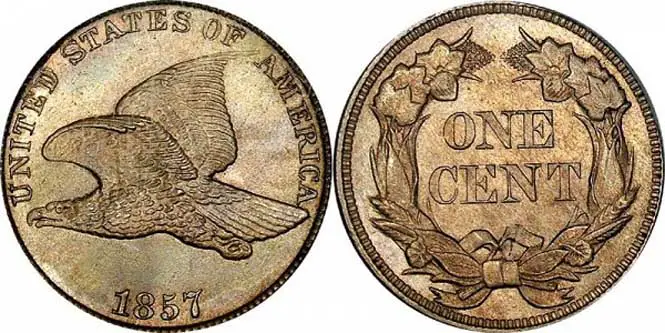 Source: USA Coinbook
Source: USA Coinbook
- Period: 1856 - 1858
- Penny: Flying Eagle
- Designer: James Barton Longacre
- Weighed: 4.7 (grams) 0.165 (ounces) 72.5 (grains)
- Diameter: 19mm
- Composed: 88% copper, 12% nickel
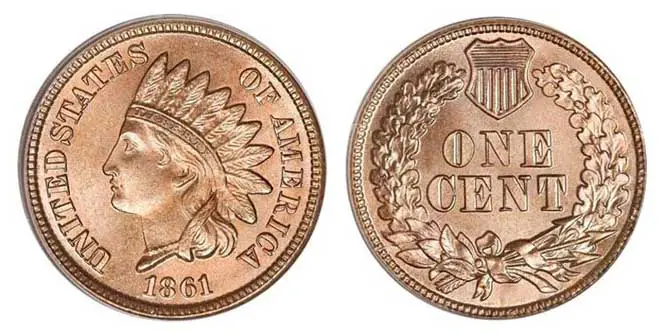 Source: USA Coinbook
Source: USA Coinbook
- Year: 1859 - 1864
- Penny: Indian Head
- Designer: James Barton Longacre
- Weighed: 4.7 (grams) 0.165 (ounces) 72.5 (grains)
- Diameter: 19mm
- Composed: 88% copper, 12% nickel
US Pennies Minted 1864 - 1942 (3.11g | 0.11oz | 48gr)
From 1864 onwards it was decided that the metals used for the Indian Head penny were going to be changed to a Bronze composite which was 95% Copper, 5% Tin and Zinc.
The design wasn't altered, however the weight changed to 3.11 grams.
1864 actually produced one of the most valuable Indian Head cents of all time.
It was a proof version of the 1864 penny known as the 'L on Ribbon' variety.
This highly sought after coin sold at auction on 13th October 2011 for $161,000.
In 1909 the Indian Head was phased out and the https://www.losttreasurehq.com/lincoln-wheat-cents.htmlLincoln Wheat was first struck.
Similar in weight and metal composition to its predecessor, these new copper pennies was designed by Victor D Brenner.
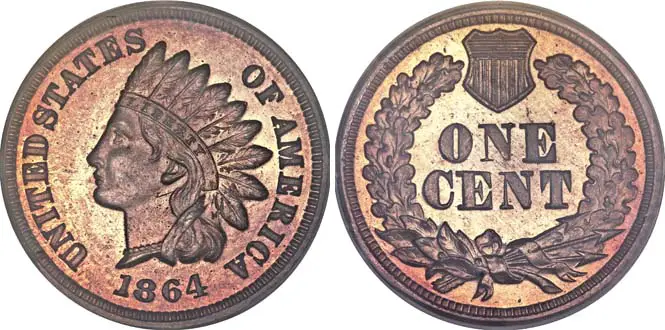 Source: Courtesy of Heritage Auctions
Source: Courtesy of Heritage Auctions
- Year: 1864 - 1909
- Penny: Indian Head
- Designer: James Barton Longacre
- Weighed: 3.11 (grams) 0.11 (ounces) 48 (grains)
- Diameter: 19mm
- Composed: 95% Copper, 5% Tin and Zinc
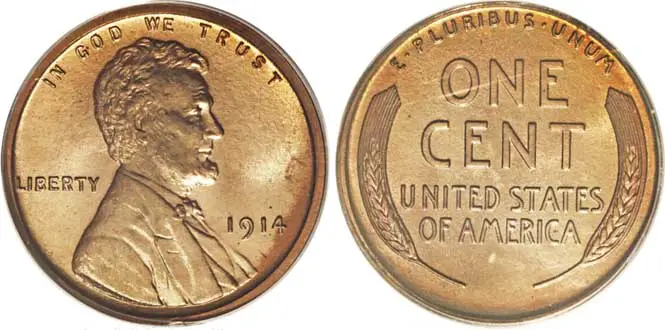
Source: Courtesy of Heritage Auctions
- Year: 1909 - 1942
- Penny: Lincoln Wheat
- Designer: Victor David Brenner
- Weighed: 3.11 (grams) 0.11 (ounces) 48 (grains)
- Diameter: 19mm
- Composed: 95% Copper, 5% Tin and Zinc
US Pennies Minted 1943 (2.7g | 0.095oz | 41.5gr)
The metals used to produced the Lincoln Wheat cent changed briefly in 1943 due to World War II and subsequently slightly altered the coin weights.
All available copper was needed to make ammunition for the ongoing war and it was decided to make the silver colored 1943 penny from zinc coated steel.
It weighed a few grams less at 2.7g and the transition in the minting process caused one of the most valuable wheat penny error coins ever to be produced.
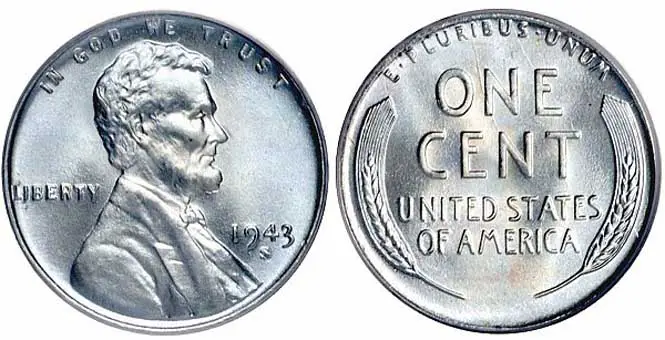 Source: USA Coinbook
Source: USA Coinbook
- Year: 1943
- Penny: Lincoln Wheat
- Designer: Victor David Brenner
- Weighed: 2.7 (grams) 0.095 (ounces) 41.5 (grains)
- Diameter: 19mm
- Composed: Zinc coated Steel
US Pennies Minted 1944 - 1946 (3.11g | 0.11oz | 48gr)
During the years 1944, 1945 and 1946, shell-case pennies as they were known, were made from Brass.
The design didn't change and they still weighed the same except they only contained copper and zinc.
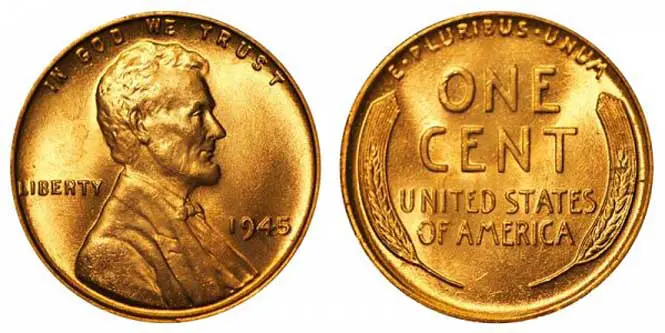 Source: USA Coinbook
Source: USA Coinbook
- Year: 1944 - 1946
- Penny: Lincoln Wheat
- Designer: Victor David Brenner
- Weighed: 3.11 (grams) 0.11 (ounces) 48 (grains)
- Diameter: 19mm
- Composed: 95% Copper, 5% Zinc
US Pennies Minted 1947 - 1961 (3.11g | 0.11oz | 48gr)
Between 1947 and 1958 the Lincoln penny was back to its original metallic composition of Bronze.
In 1959 a new design was released by the US mint called the Lincoln Memorial.
The new coin was designed by Frank Gasparro and featured an image of the Lincoln Memorial on the reverse.
The current weight of 3.11 grams remained the same.
 Source: USA Coinbook
Source: USA Coinbook
- Year: 1947 - 1958
- Penny: Lincoln Wheat
- Designer: Victor David Brenner
- Weighed: 3.11 (grams) 0.11 (ounces) 48 (grains)
- Diameter: 19mm
- Composed: 95% Copper, 5% Tin and Zinc
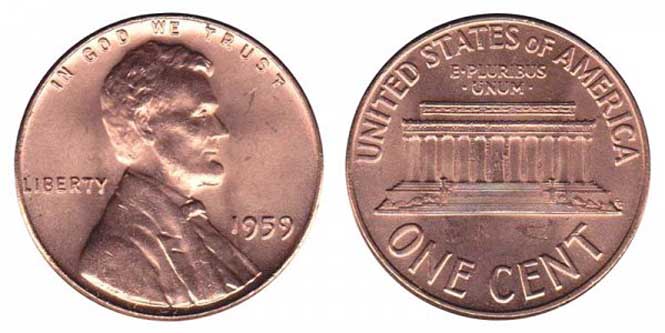 Source: USA Coinbook
Source: USA Coinbook
- Year: 1959 - 1961
- Penny: Lincoln Memorial
- Designer: Frank Gasparro
- Weighed: 3.11 (grams) 0.11 (ounces) 48 (grains)
- Diameter: 19mm
- Composed: 95% Copper, 5% Tin and Zinc
US Pennies Minted 1962 - 1981 (3.11g | 0.11oz | 48gr)
In 1962 the U.S. pennies returned to being made from Brass as opposed to Bronze, however the weight remained at 3.11 grams.
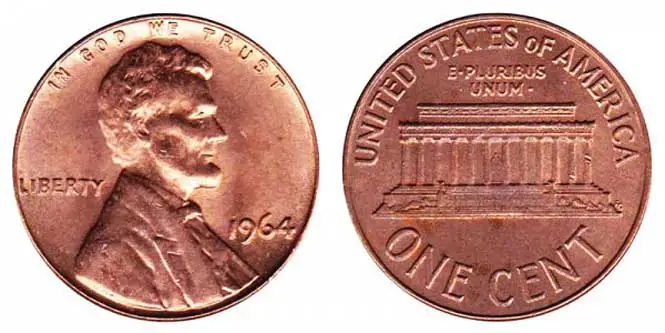 Source: USA Coinbook
Source: USA Coinbook
- Year: 1962 - 1981
- Penny: Lincoln Memorial
- Designer: Frank Gasparro
- Weighed: 3.11 (grams) 0.11 (ounces) 48 (grains)
- Diameter: 19mm
- Composed: 95% Copper, 5% Zinc
US Pennies Minted 1982 - 2008 (2.5g | 0.088oz | 38.5gr)
1982 saw the first major change to the Lincoln penny since Frank Gasparro redesigned it in 1959.
The metals used to produce the penny changed to 97.5% Zinc core with a 2.5% Copper plating and the weight also changed to 2.5 grams.
This is the lightest the one penny coin has ever been since it was first produced in 1793.
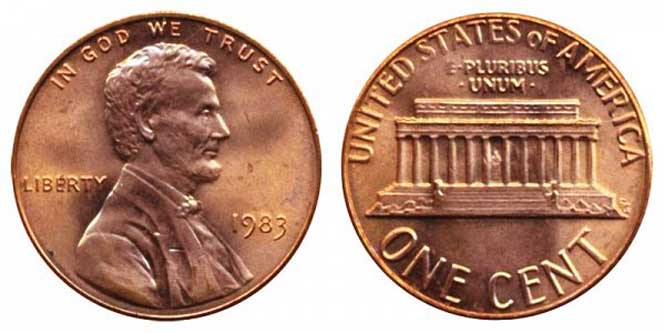 Source: USA Coinbook
Source: USA Coinbook
- Year: 1982 - 2008
- Penny: Lincoln Memorial
- Designer: Frank Gasparro
- Weighed: 2.5 (grams) 0.088 (ounces) 38.5 (grains)
- Diameter: 19mm
- Composed: 97.5% Zinc, 2.5% Copper
US Pennies Minted 2009 (3.11g | 0.11oz | 48gr)
The 2009 one cent piece was a special strike specifically for that date to celebrate the bicentennial of Abraham Lincoln.
Four different designs were created for coin collectors in 2009 by four different designers to commemorate his 200th birthday.
The first reverse featuring a log cabin in Kentucky was designed by Richard Masters and sculpted by Jim Licaretz celebrating the former president's birthplace and early childhood.
The formative years in Indiana reverse face was designed and sculpted by Charles Vickers.
It depicts a young Lincoln taking a break from rail splitting and reading a book.
The next design by Joel Iskowitz, sculpted by Don Everhart, is titled, 'Professional life in Illinois' and depicts Lincoln standing before the Springfield Illinois State Capitol as a young lawyer.
The fourth reverse design was created by Susan Gamble and sculpted by Joseph Menna.
It depicts a half completed dome from the US Capitol building.
This last design was to signify Lincoln's presidency in Washington DC.
The proof and satin finish strike of the 2009 Lincoln penny were made from the same Bronze metal composition that was used on the first version of the Lincoln Wheat in 1909.
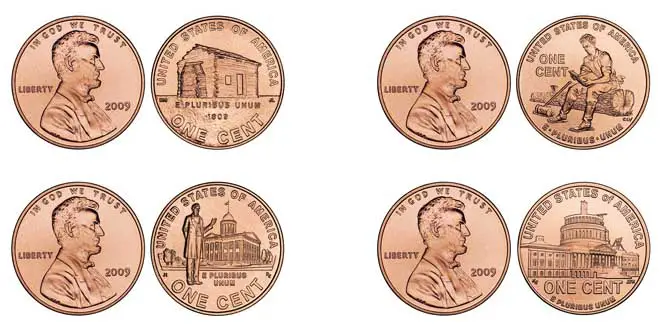 Source: USA Coinbook
Source: USA Coinbook
- Year: 2009
- Penny: Lincoln Bicentennial Series (Proof & Satin Finish)
- Designer: Various
- Weighed: 3.11 (grams) 0.11 (ounces) 48 (grains)
- Diameter: 19mm
- Composed: 95% Copper, 5% Tin and Zinc
US Pennies Minted 2010 - present (2.5g | 0.088oz | 38.5gr)
The most current design of the of the US penny is the Lincoln Shield and was created by Lyndall Bass. You may notice that it has reverted back to the Zinc core with a copper plating.
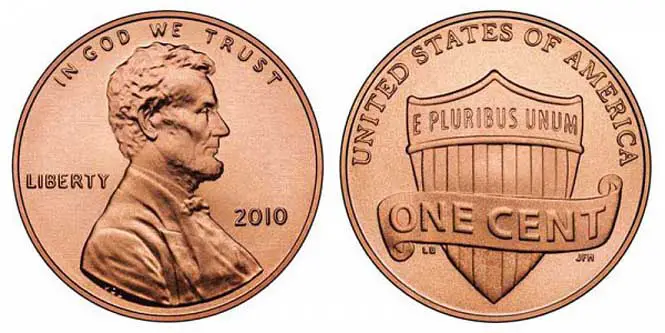 Source: USA Coinbook
Source: USA Coinbook
- Year: 2010 - present
- Penny: Lincoln Shield
- Designer: Lyndall Bass
- Weighed: 2.5 (grams) 0.088 (ounces) 38.5 (grains)
- Diameter: 19mm
- Composed: 97.5% Zinc, 2.5% Copper
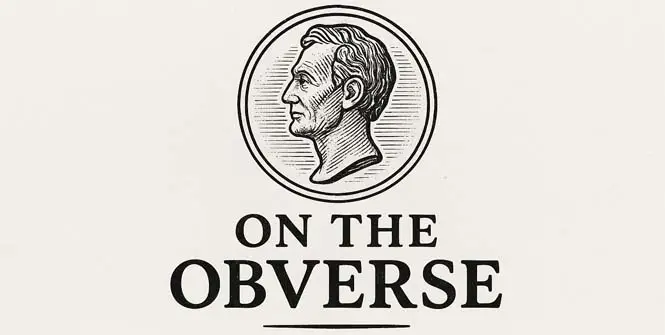
Would You Like To Receive More Exciting News And Information About Coin Collecting Direct To Your Inbox?
Enter your email address below, check the boxes and click Send It To Me! now to get your FREE copy of On The Obverse newsletter.
